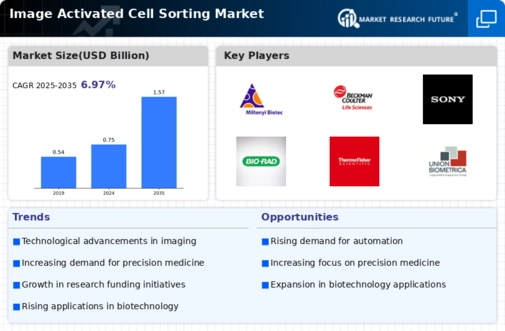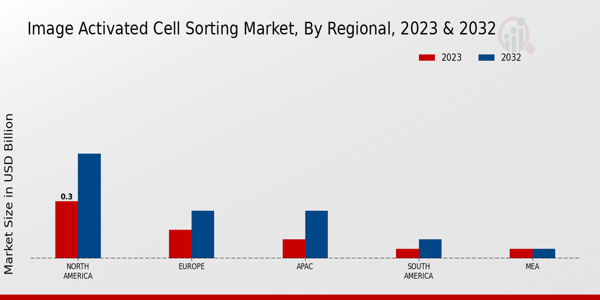Market Growth Projections
The Global Image Activated Cell Sorting Market Industry is projected to experience substantial growth, with estimates indicating a rise from 0.75 USD Billion in 2024 to 1.57 USD Billion by 2035. This growth trajectory suggests a compound annual growth rate of 6.96% from 2025 to 2035. The increasing adoption of image-activated cell sorting technologies across various sectors, including research, healthcare, and biotechnology, is likely to drive this expansion. As the market evolves, stakeholders are expected to capitalize on emerging opportunities, further enhancing the industry's potential.
Technological Advancements
The Global Image Activated Cell Sorting Market Industry is experiencing rapid technological advancements that enhance sorting efficiency and accuracy. Innovations in imaging technologies, such as high-resolution microscopy and advanced algorithms, allow for precise identification and sorting of cells based on specific characteristics. These advancements not only improve the throughput of cell sorting processes but also reduce the time required for analysis. As a result, the market is projected to grow from 0.75 USD Billion in 2024 to an estimated 1.57 USD Billion by 2035, reflecting a robust CAGR of 6.96% from 2025 to 2035.
Increasing Demand in Research
The Global Image Activated Cell Sorting Market Industry is driven by the increasing demand for advanced cell sorting techniques in research and clinical applications. Researchers are increasingly utilizing image-activated cell sorting for applications such as cancer research, immunology, and stem cell research. This demand is fueled by the need for high-purity cell populations for experimental reproducibility and therapeutic development. As research institutions and biotechnology companies invest in advanced sorting technologies, the market is expected to expand significantly, supporting the growth trajectory observed in recent years.
Supportive Regulatory Framework
The Global Image Activated Cell Sorting Market Industry benefits from a supportive regulatory framework that encourages innovation and adoption of new technologies. Regulatory bodies are increasingly recognizing the importance of advanced cell sorting techniques in research and clinical applications. This support facilitates faster approval processes for new devices and technologies, thereby promoting market growth. As regulations evolve to accommodate advancements in imaging and sorting technologies, the industry is likely to experience enhanced investment and development opportunities, further driving the market forward.
Rising Applications in Healthcare
The Global Image Activated Cell Sorting Market Industry is witnessing a surge in applications within the healthcare sector. This technology is being increasingly adopted for diagnostic purposes, particularly in identifying and isolating rare cell types associated with various diseases. For instance, the ability to sort circulating tumor cells from blood samples has significant implications for cancer diagnostics and treatment monitoring. As healthcare providers recognize the potential of image-activated cell sorting in improving patient outcomes, the market is likely to see substantial growth, driven by the need for more precise and personalized medical interventions.
Growing Investment in Biotechnology
The Global Image Activated Cell Sorting Market Industry is bolstered by growing investment in biotechnology and life sciences. Venture capital and government funding are increasingly directed towards innovative technologies that enhance research capabilities and therapeutic development. This influx of capital supports the development and commercialization of advanced image-activated cell sorting systems, enabling researchers and clinicians to leverage these technologies for improved outcomes. As the biotechnology sector continues to expand, the demand for sophisticated cell sorting solutions is expected to rise, contributing to the overall growth of the market.




















Leave a Comment